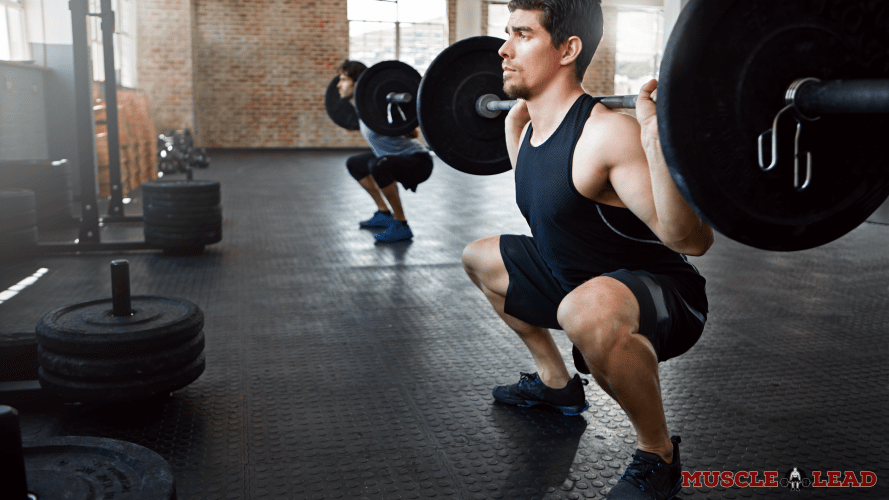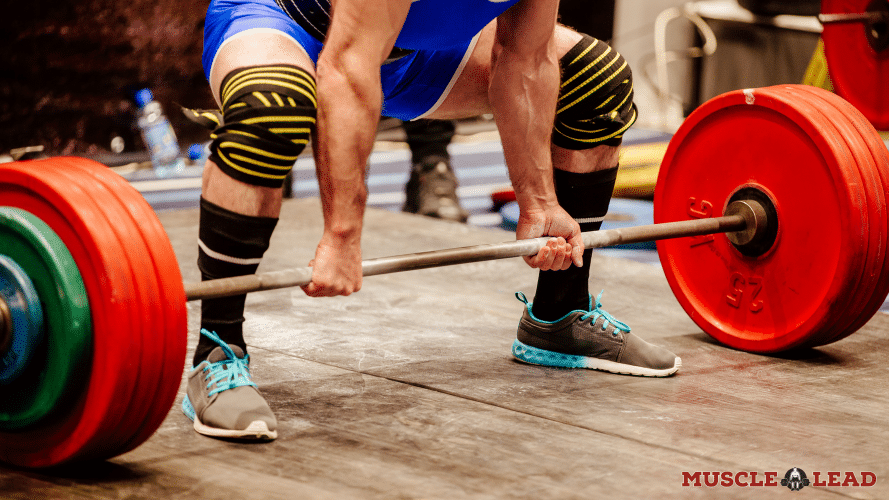Key Points
- You should use a lifting belt for deadlifts and squats:
- Engages the core stability muscles properly
- Keeps the spine in a safe position
- May allow you to rack up a few extra pounds on the barbell
- Increases confidence whilst squatting
- Remember, the powerlifting belt is NOT compulsory but can certainly be an asset to your squats, deadlifts, and other heavy compound movements.
The pursuit of finding the perfect training accessory in 2023 continues.
Now you may see some people in the gym with a belt on and you’re curious. Should you wear a belt for squats and deadlifts?
The powerlifting belt is a crucial lifting accessory, even though it is often misunderstood for what it can and can’t do.
This lifting belt is utilized by a variety of health and fitness enthusiasts, from recreational lifters to elite powerlifters.
The powerlifting belt is key in maximizing performance in the safest way possible. That being said, the powerlifting belt should only be employed under certain circumstances.
Within this article, I have covered how the powerlifting belt can help with squats and deadlifts, what does it not do? How and when to use it, and if its necessary for your training regimen.
How Lifting Belts Can Help You with Squats and Deadlifts
I have highlighted two main reasons why you may want to consider the powerlifting belt. As a beginner lifter moving towards intermediate levels, these reasons are critical in your decision.
Ensuring Spinal Neutrality
We should NEVER undervalue the use of a powerlifting belt while performing brutal compound lifts like the squat and deadlift. During such load-bearing exercises, a great deal of stress is placed on the body, especially the spine.
The powerlifting belt help in stabilizing the core stability muscles and maintaining a neutral spine throughout an exercise.
So what happens if we don’t brace the core? If we don’t prioritize bracing our core during exercises like the squat, there is an increased risk of spinal curvature, which can damage tissues surrounding the spine.
A survey study found that 90% (85/94) of experienced lifters used the powerlifting belt to prevent spinal injuries.
How to Brace with a Belt – 4 Factors to Consider
Maximize Lifting Performance
It should come as no surprise that you will be able to lift more weights by bracing tightly and maintaining proper movement mechanics. Let’s say that you were unable to maintain good core stability and your spine curved at the spine just for a second. As a result, your squat will lose energy and chances are you could fail the lift, or at worst injure yourself.
For example, let’s use the analogy that you are performing a 5RM Barbell Squat. You get close to the bottom of the squat position and your core isn’t braced.
As a result, your spine begins to cave in. You lose your stability and lose all that eccentric energy. Drop the weight and you have failed the lift.
I don’t mean to scare you, but this is the reality and we see it happen in the gym all the time.
A study by Zink et al.(2) found that lifters who used a powerlifting belt were able to perform the barbell squat at 90% intensity.
The lifters were able to induce a 3-5% greater velocity, thus enabling them to perform more reps. In the long term, this outcome can modify strength and hypertrophy (muscle mass).
What does the Powerlifting Belt NOT Do?
On the opposite side of the spectrum, there are many lifters who overestimate the usefulness of the powerlifting belt. I have mentioned two variables below that are commonly believed in the mainstream lifting scene, but are not fully accurate.
Guarantee Injury Prevention
Although a powerlifting belt can reduce the risk of spinal injuries, there are no guarantees. So, don’t make any sudden changes to your major compound lifts from overconfidence. You should always observe all of the key lifting points such as:
- Bracing the core
- Maintaining a neutral spine position
- Maintaining proper form
- Breathing throughout the exercise
- Do NOT increase weight drastically
Reduce Waist Size
Contrary to common belief, the powerlifting belt does not change waist size. The size of your midsection entirely depends on hip bone positioning and body fat levels.
You can change your waist with a fat loss program but there are limitations. Being able to control your core is a whole different rant and can be modified via core stability exercises.
At What Weight Should I Use a Belt For Squats?
For squatting, once you can lift 1.25 times your bodyweight, a lifting belt is a great idea.
The lifting belt at this strength level can help improve performance and provide safety at high loads.

I would recommend a lifting belt for workouts where you squat at an intensity of 80% or more.
At What Weight Should I Use a Belt For Deadlifts?
As a general rule of thumb, once you’re able to deadlift 1.5 times your bodyweight you can start using a lifting belt. At this strength level, you should have good fundamentals for breathing and be able to adapt to the belt quickly.

Personally, I like to recommend the powerlifting belt during strength and hypertrophy-based sessions, within the intensity of 75-100%, which sits around 1-10 reps.
To put this into perspective, a competitive powerlifter may opt to use the belt during the following deadlift reps and loads.
- 1 x 617 lbs = @100% intensity
- 2 x 584 lbs = @95% intensity
- 3 x 573 lbs = @93% intensity
- 4 x 551 lbs = @90% intensity
- 5 x 540 lbs = @87% intensity
- 6 x 529 lb = @85% intensity
- 7 x 507 lb = @83% intensity
- 8x 485 lb = @80% intensity
- 9 x 473 lb = @77% intensity
- 10 x 462 lbs = @75% intensity
How to Use a Lifting Belt for Squats and Deadlifts
You’re probably eager by now to know how to wear the powerlifting belt for squats and deadlifts. I’ve put together a step-by-step guide.
STEP 1: Place the center of the inner fabric of the belt just above the lumbar region of the spine (lower back). It usually wraps around your love handles.
STEP 2: Wrap the belt around the waist, close to the belly button, but below the rib cage. For deadlifts, I choose a slightly lower position and for squats I choose a higher position.
STEP 3: Clip the belt tight enough that you can press your core against the belt. But not so tight that you can’t breathe. Use your finger to run across the length of the belt so you can test the tightness.
STEP 4: Perform the lift and then remove the belt immediately in-between sets.
How Tight Should My Lifting Belt Be
Is the Powerlifting Belt Necessary?
NOPE! Regardless of our rant, the powerlifting belt may offer some additional support during heavy lifting, but it isn’t required for lifting. You can very well brace your core and maintain spinal neutrality without wearing a powerlifting belt.
One thing I dislike is the powerlifting belt being used as a ‘fashion’ statement. A lot of ‘gym goers’ just wear it during random low-load lifts (1), just to draw some attention. This does not make you look tough and is almost comical.
FAQs
You absolutely can, especially whilst lifting heavy! The squat is a load-bearing exercise, where it is crucial to brace the core and prevent the spine from curving forward.
Although the deadlift does not place constant tension on the spine unlike the squat, spinal neutrality is still crucial, so the powerlifting belt can be a great asset.
Final Thoughts
All in all, should you wear a belt for squats and deadlifts? Yes as you get stronger it can improve squatting and deadlifting performance. In addition, the powerlifting belt may help prevent injury.
There is no guarantee that the powerlifting belt is injury proof, so don’t get overconfident. Always follow the key points to perform a lift safely and effectively with suitable loads.
The next time someone tells you that the powerlifting belt can reduce waist size, call out their bluff and refer to this article.
As we established, the powerlifting belt can easily be applied using our 4-step guide, ensuring that the belt is tight enough to push the core against but loose enough for you to breathe.
Typically, I would suggest using the powerlifting belt whilst lifting heavy weights above 75% intensity. Don’t be that guy that walks around the gym with a powerlifting belt whilst doing light bicep curls.
Remember, the powerlifting belt is NOT compulsory but can certainly be an asset to your squats, deadlifts, and other heavy compound movements.
References
- Finnie, S. B., Wheeldon, T. J., Hensrud, D. D., et al. Weight lifting belt use patterns among a population of health club members. Journal of Strength and Conditioning Research. 2003; 17(3): 498-502
- Zink, A. J., Whiting, W. C., Vincent, W. J., et al. The effects of a weight belt on trunk and leg muscle activity and joint kinematics during the squat exercise. Journal of Strength and Conditioning Research. 2001;15(2):235-240.
More about Lifting Belts:





